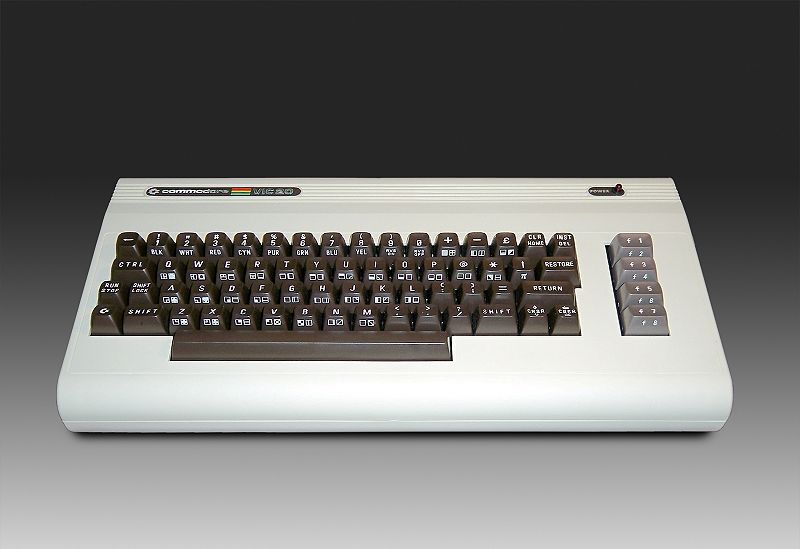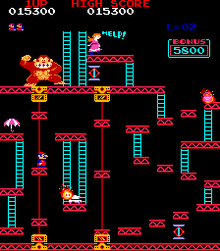(As this Blog emerges from the Eighties and onwards it will start to change into my Personal Gaming History)
- The Middle Ages -
There are already indications of gamers being sucked in by the next and best allure of new gaming technology as early as 1977.
With better consoles arriving on the shelves, companies were forced to sell their now obsolete systems, at a loss, to clear stock.
A trend which has persisted to this day. How else would they make their money?
Unfortunately we, as neophiles, are easily succeptable to this retail stratergy.
And companies will exploit that, it seems, without considering the consequences to their own lively-hood.
And companies will exploit that, it seems, without considering the consequences to their own lively-hood.
Enter the 'Home Computer'
Gamers soon became bored of 'Pong Clones', because the market was over-saturated with similar types of games. The new trend of 'Multi-User Dungeon' RPG's had taken off.
Previously, this type of game was limited to University Mainframe Computers, designed by students, when they should have been studying. Some things never change :)
Initially starting out as 'Text-based' adventures they evolved into rudimentary graphical scenes.
Comparable to illustrated pages in novels, which they used, alongside D&D, as an influence.
Previously, this type of game was limited to University Mainframe Computers, designed by students, when they should have been studying. Some things never change :)
Initially starting out as 'Text-based' adventures they evolved into rudimentary graphical scenes.
Comparable to illustrated pages in novels, which they used, alongside D&D, as an influence.
 |
| 'Spellbinder' 1987 on the BBC Micro We were allowed to play this at school when it rained |
With the revelation that using a game's source code (obtained from magazines and books) the consumer could program their own versions of existing video games.
Soon amateur programmers began selling their own iterations of popular titles in local shops on floppy disks, cassette tapes and ROM cartridges. which could also be sent using the postal service.
Talk about convenience \{^u^}/

Richard Garriott's 'Akalabeth: World of Doom' is one of the more celebrated 'hobbyist' games. Which he designed when he was a teenager in 1980.
Initially selling fifteen copies at a local ComputerLand store, once California Pacific Computer Company had purchased the rights to publish the game, it went on to sell 30,000 copies.
With the release of VIC-2O computer.
A competing rival, in the retail stores, to the already established home consoles.
Check out the advertisement - (Captain on Deck!)

By 1983, the VIC-20 became the first computer in history to pass the 1 million units mark.
It is by this milestone that varying genres of games became more defined:
Action-Adventure Games - Puzzles, item collecting and a story to drive you to completion.
This is a good example of the environment being almost a character in the make-up of the game. Becoming more complex the further you progress.
This is a good example of the environment being almost a character in the make-up of the game. Becoming more complex the further you progress.
(These are represented at this point in time by Text or Graphics.)
West of House
You are standing in an open field west of a white house,
with a boarded front door.
There is a small mailbox here.
 |
| Your imagination plays a huge part in these games. You are building the environment as you go onwards. |
 |
| Manic Mansion A break through game that introduced better graphics. |
I remember, playing through one of the 'Tomb Raider' games, when you first emerge from a dank, dark, claustrophobic cave into and enormous and expansive valley and being just blown away.
And even more so, when playing Uncharted 2: Among Thieves.
There are some really impressive vistas to behold.
And even more so, when playing Uncharted 2: Among Thieves.
There are some really impressive vistas to behold.
 |
| Uncharted 2 by NAUGHTY DOG 2009 |
Beat 'em ups/Hack 'n' Slash - Battling wave upon wave of enemies of increasing difficulty by 'button bashing'.
 |
| Kung-Fu Master doing two guys at once...er...yeh :s |
| Released in 1986 - Renegade |
 |
| Karate Champ by TECHNOS 1984. Looks like the contest was judged by 'Sifu' Ron Jeremy |
Fighting - One on one contests of increasing difficulty \{~_<}/
Me and my brother (Aaran) played 'Yie Ar Kung-Fu to death!
Probably because, on the 'Amstrad CPC', it was the fastest loading game on tape :D
Me and my brother (Aaran) played 'Yie Ar Kung-Fu to death!
Probably because, on the 'Amstrad CPC', it was the fastest loading game on tape :D
 |
| Yie Ar Kung-Fu by KONAMI 1985 |
 |
| Yie Ar Kung-Fu II on the AMSTRAD CPC (Ugly!) |
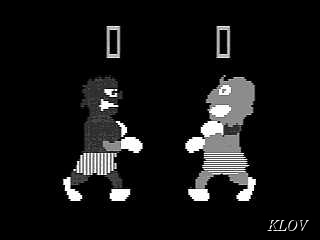 |
| Heavyweight Champ by SEGA 1976 |
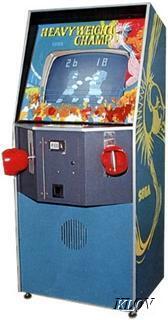 |
| Heavyweight Champ Arcade |
Although a lot of the games released at the time were just cartridge based clones of popular Arcade titles, more and more unique genre defining games emerged.
Interactive Movies - Dragon's Lair was the first Arcade game to feature full-motion video animation.
This was due to it being contained on Laserdisc.
It was also the first game to cost $0.50 a go. Twice the price of your average Arcade Machine.
Dragon's Lair can be seen, alongside Pong and Pac-Man, displayed in the Smithsonian in Washington D.C.
I always wanted to play this game but never had the opportunity.
I always wanted to play this game but never had the opportunity.
 |
| Dragon's Lair by CINEMATRONICS 1983 |
Maze Games - Logic or just lunch? Navigate your character through a series of Mazes!
 |
| Pac-Man - DOB: 22/05/1980 Probably the most famous video game protagonist. (23 days older than me) |
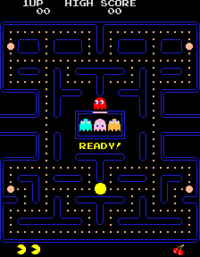
 |
| "Ooh scary!" 3D Monster Maze 1982 by J.K. Greye Software |
 |
| 'Hand-Held Coleco Pac-Man' I had one of these for a Christmas present at some point in the 80's. Pac-Man looks like he's on PCP :) |
Platformer Games - Swing, bounce or jump through "platform" environments. Made popular by Nintendo's Mario titles.
 |
| "I've come to fix your plumbing" said Mario "Be careful" replied Princess Peach "It's full of angry mushrooms!" |
 |
| Space Panic by UNIVERSAL 1980 |
Platform Adventure Games - A sub-genre, combining elements of game-play from RPG's, Action-Adventure, Shooters and Hack 'n' Slash. With the feature to freely explore levels by upgrading the characters abilities with "Power-Ups!"
Like RPG's the player explores a 'Dungeon' defeats a 'Boss' then progresses to the next 'Level'.
A great format, simple but effective \{*o*}/
Like RPG's the player explores a 'Dungeon' defeats a 'Boss' then progresses to the next 'Level'.
A great format, simple but effective \{*o*}/
 |
"RockMan" or "MegaMan" or "MegaMan.EXE, Volnutt, X, Model A, Geo Stelar, Model ZX", etc I don't know anymore ;p |
 |
| Metroid Co-developed by NINTENDO and INTELLIGENT SYSTEMS 1986 |
 |
| Zelda II: The Adventure of Link by NINTENDO 1987 |
Racing/Vehicle Simulation Games - Simulated racing experiences. Over time the emphasis has focused on being ultra-realistic.
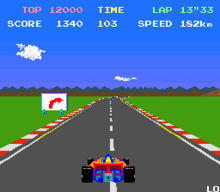 |
| Pole Position by Namco 1982 |
 |
| Forza Motorsport 3 2010 |
My brother I used to play 'Outrun, Operation Wolf and Hang on' at the Arcades if we ever saw them.
But my parents considered arcades "a waste of money" so it was a rare experience, but great none the less :)
Rhythm Games - Find the rhythm! Stay in time! Get points! Hooray!
Dance Aerobics, a music video game, was published by 'Bandai' in 1987.
(I had no idea there were games of this genre so early on in the genesis of 'Video Games'.)
 |
Power Pad accessory for Bandai's Family Trainer series 1987 |
Games for people who have all their limbs! |
This genre became increasingly popular in the 1990's and has stayed strong to date with the help of over-televised "talent" shows that saturate the networks.
Now we have a "RockBand" and a "Guitar Hero" in every home. Joy!
 |
"So, you can't be bothered to LEARN to play an instrument" "This box of plastic lies is for you" |
Role-Playing Games - Taking a massive influence from 'Dungeons & Dragons' pen and paper RPG's, minus a "Games master", this sub-genre of Adventure games, has spawned from very humble origins to being one of the most profitable and enjoyable forms of gaming to date.
 |
| "\{>o<}/ I'm redundant!" |
A comparison of the ever present similarities in an RPG's layout, even though twenty two years apart!
 |
| Part of the hugely successful Franchise "Megami Tensei" Shin Megami Tensei: Digital Devil Saga by ATLUS 2004 |
Having a well developed storyline and more importantly character development gives the player a sense of achievement and immersion that sets it apart from other genres.
 |
| FF XIII by SQUARE-ENIX 2010 |
I was an impatient gamer as a child and it was only when I began taking an interest in Art and Illustration that the skill involved 'Pushing Pixels' in games dawned on me.
 |
| Even though the character types have that "Chibi" look to them, what they represent is executed with skill |
| "Kawaii ne?" |
Scrolling Shooters/ Shoot 'em up - The success of 1980 breakthrough title 'Defender', encouraged developers to create more complex and challenging games.
Later, in titles such as R-Type, ships could be upgraded to deal with the increasingly difficult enemies that relentlessly poured onto screen.
And R-Type was very difficult! If the enemies didn't get you, the scenery usually did :D
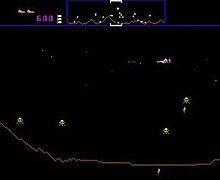 |
| Defender by Williams Electronics 1980 |
 |
| A Japanese flyer for R-Type. Someone likes 'Giger' |
Stealth Games - Avoid your enemies. It's espionage! Unless your Solid Snake. Then just take all of them out one by one.
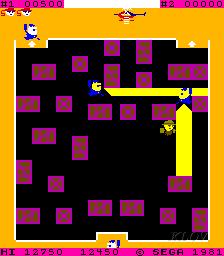 |
| 005 The First Stealth Arcade Game SEGA 1981 |
Metal Gear, the pioneer of Stealth Games, has stayed the course for nearly twenty seven years.
 |
| Metal Gear 1987 Konami |
With each release expanding on the original storyline to become a very intricate and mature observation of the affects of war on our world and on the individual witnessing it.
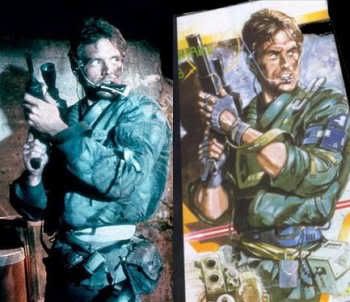 |
| Michael Biehn IS Solid Snake! |
 |
| Metal Gear Solid 4 by KONAMI 2008 |
Survival Horror - Navigating a vulnerable character through an unknown location with mysterious creatures snapping at your heels. Instant win!
One of my favourite genres.
The fact that a game can affect so much tension through game-play is a testament to this genres success.
Validating itself as a form of genuine artistic entertainment.
Although 'Haunted House' by Atari was the first Horror game, 'Sweet Home' established the 'Survival' aspect of the genre.
Serving as the inspiration for such great games as 'Resident Evil' and 'Silent Hill'.
One of my favourite genres.
The fact that a game can affect so much tension through game-play is a testament to this genres success.
Validating itself as a form of genuine artistic entertainment.
Although 'Haunted House' by Atari was the first Horror game, 'Sweet Home' established the 'Survival' aspect of the genre.
Serving as the inspiration for such great games as 'Resident Evil' and 'Silent Hill'.
 |
| Haunted House by ATARI 1981 |
 |
| Sweet Home's first level 1989 |
 |
| (The Inappropriately titled) Sweet Home by CAPCOM 1989 |
 |
| "BRAAAIINS!" Resident Evil by CAPCOM 1996 |
This, in turn made us jump, adding to the overall enjoyment playing the game.
At this point in 'Video Game History' they are considered to be just a novelty, yet the potential is there and the foundations, clearly, are set. This is the Golden Age.
History then repeats itself.
Rather than learn from the unfortunate events that preceded it, the 'Home Console' began to flood the market with low-quality, yet high-profile games.
"Quantity over quality" seemed to be their business acumen.
Programmers of 'Atari' were criminally unappreciated for their efforts.
Having never being credited for their work, a number of them were left with no choice but to depart from the company.
This prompted them to set up the first legitimized 'Third-Party Developer' 'Activision' in 1979.
'Atari' shoulder most of the blame for the impending 'crash'.
Rushing development of high-profile games, to take advantage of the Christmas sales, instead producing some of the worst games to ever be made.
 |
E.T. the Extra-Terrestrial by ATARI 1982 That green block is supposed to be him |
Despite many innovations in technology and design, companies vied for consumer attention.
Yet, set against 'PC's' they could not hold the markets interest.
You couldn't even save your game on earlier 'Home Consoles'.
An essential function that 'PC's' held over them all, aside from 'word-processing' and, if inclined 'home accounting'.
With the continuing development of more complex games, this restriction fed consumers frustrations.
Once again, retailer's shelves were over-saturated with new consoles and games.
But with publishers closing doors left, right, up up down down left right left right b a start and centre they had no choice but to 'bargain bin' the lot.
Console-based video games were branded a "fad" by retailers and were consequently ignored for nearly five years.
America suffered most in this period 1983 - 85, but in Europe 'Home Computers' had been cleverly marketed to incorporate games into their appeal.
And the European market was thriving. Particularly Manchester based 'Ocean Software' who managed to get an impressive amount of Licensed games published.
From around the late 80's (1987, I believe) we had an Amstrad CPC-464.
We had a mixture of games none that I can recall with any clarity.
My brother ran off a massive list straight away when I asked him, but these games I've added, stuck with me, so they get the mention.
Batman
Flying Shark = My Dad's favourite game :D
Nomad
Spy vs Spy
Robocop = Considerably violent!
Roland in The Caves = Epic
Ghostbusters II = A long, long wait for a quick death
Firelord was extremely addictive but I was absolutely rubbish playing it!
Barbarian = I loved doing the web of death sword move \{"u"}/
Dizzy = The most bizarre game I ever played at the time
Check him out!
 |
| "Aww! Look at his lil' Bat Feet!" |
 |
Flying Shark by TAITO 1987 An old favourite in my household, although looking at it now, it looks at bit crap :( |
Games were stored on inexpensive floppy disks which in turn lowered the price of 'Computer Games'.
And European Publishers were now insulated from the pitfalls that had toppled the American market.
 |
| Robocop by Ocean 1988 (Arcade version) |
 |
| Robocop by Ocean 1988 (AMSTRAD version) He's looking "Minty fresh" |
Meanwhile, in Japan, 'Video Games' and 'Home Consoles' had flourished with the culmination of this magic box:-
 |
NES (Nintendo Entertainment System) "I am known by many names" "Some call me 'Hyundai Cowboy', others know me as 'Dendy' or 'Little Master" |
http://www.youtube.com/watch?v=udsNGyfohGQ
Originally developed in Japan as early as 1983, under the name 'Famicom' (Family Computer) it is an 8-Bit Video Game Console. Gone were the 'Joysticks', replaced by two 'Game pad' controllers.
Originally developed in Japan as early as 1983, under the name 'Famicom' (Family Computer) it is an 8-Bit Video Game Console. Gone were the 'Joysticks', replaced by two 'Game pad' controllers.
This interface was to become the standard for the new 'Third Generation Consoles'.
The 'NES' was a hard sell to the west.
A clever marketing gimmick which actually only worked with two games.
With this new console, Nintendo also brought about 'Licensing Restrictions' to control 'Third-Party Development'.
A 'Golden Seal of Approval' was placed on all games released by Nintendo coupled with a 'Lock-out System' that needed a key chip in the cartridge to work with console.
Publishers also had to buy the cartridges outright from Nintendo and take full responsibility for any loss in sales themselves.
Quite a shrewd business manoeuvre. A games developer simply could not afford to make a 'turkey' or the losses would be commercially catastrophic.
On a personal note, I had never even played on a NES until 1990. When I was visiting my relatives in Canada.
They had a huge television screen which then hosted 'Punch Out' and 'Duck Hunt' tournaments between our families. It was amazing!
I am "Reigning Champ" of a small suburban household of Toronto.
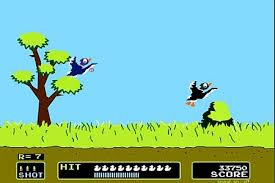
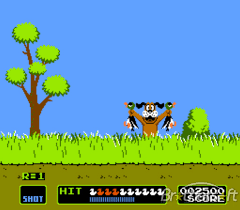
Publishers also had to buy the cartridges outright from Nintendo and take full responsibility for any loss in sales themselves.
Quite a shrewd business manoeuvre. A games developer simply could not afford to make a 'turkey' or the losses would be commercially catastrophic.
On a personal note, I had never even played on a NES until 1990. When I was visiting my relatives in Canada.
They had a huge television screen which then hosted 'Punch Out' and 'Duck Hunt' tournaments between our families. It was amazing!
I am "Reigning Champ" of a small suburban household of Toronto.
| 'Punch Out' Mario was the Referee :D |
A noticeable difference in games, that I myself realised around this time, was that the game-play had really improved in these new titles.
That is not to say that it was anything new, it just felt a lot tighter. Better honed, crafted.
The Japanese have an intrinsic understanding of games.
How to improve their performance and appeal.
This is how Nintendo dominated the Games Industry for several years, even dictating terms for many 'Third-Party Developers' on their output. This was restricted to five Nintendo titles a year.
Aside from Nintendo, there were six other companies in Japan that benefited from the new business model:
BANDAI
CAPCOM
HUDSON SOFT
KONAMI
NAMCO
TAITO
These companies manufactured cartridges for Nintendo and even made additional improvements in performance to their own releases.
The NES became the "best-selling games console of it's time" retiring in Japan in September 2003 after an impressive 21 years of production.
Although in the UK it still had competition!

The SEGA 'Master System'
(We spent nearly everyday, after school, piled around my friends TV playing 'Operation: Wolf)
Another Japanese console which had a frosty reception in the USA, we readily took them into our homes.
In my opinion it was a much better console than the NES. It had better graphics and featured either 'Card' or 'Cartridge' games and it hosted built-in games when neither were inserted.
| The pre-installed 'Alex Kidd' There were many 'Alex Kidd' games this one must be 'Alex Kidd and the Pink Snake from Chocolate Lake' |
'Alex Kidd' SEGA's first mascot |
a 16-bit 'Fourth Generation Console'.
 |
| Sonic The Hedgehog SEGA's attempt to inject some cool into their mascot. Isn't anti-freeze blue? What is he going to do with that finger? |
 Sega were fiercely trying to topple Nintendo's position in the market.
Sega were fiercely trying to topple Nintendo's position in the market. Despite the NES being a meagre 8-bit console it held it's own for a few more years. (As I mentioned above 21 years in production!)
This sparked a 'console war' between the two companies.
Each trying to belittle the other's place in the new 16-bit realm.
'Sonic The Hedgehog' is the most recognisable video game character created to date, so SEGA have easily that achievement under their belt. :)
http://www.gametrailers.com/user-movie/really-old-sega-genesis-commercial/279706
http://www.gametrailers.com/user-movie/sega-genesis-ad-genesis-does/20054
Nintendo had no choice but to ask Masayuki Uemura, the original designer of 'Super Famicom/NES', to design a new console to compete with their 16-bit rivals.
In my opinion, one of the best looking consoles ever produced.
It has such practical aesthetics. 'No manual necessary' design.
The choice for us was easy. "Please can we have a SNES!"
(It was also around 1992 that my parents decided to retire the Amstrad for a Commodore 1200, to aid them with home finances, help out with our homework, mess about with Deluxe Paint and play even more games.)
 |
| Ah! New Zealand Story, how I miss you :'( |
 |
| Commodore Amiga 1200 |
My brother and I soon decimated our controllers for the SNES.
I blame StreetFighter II \{>n<}/
With new pads in hand, we returned to this console with gusto.
Everything was so bright and colourful. And console itself looked great!
Did I already mention that?
Nintendo games had a very wholesome image in our minds, which was different to previous games played on the Amstrad and the Commodore.
This made the gaming experience fun again.
I had found some games frustrating on earlier platforms, either from poor graphics or just really inept game-play.
(Aliens and NightBreed spring to mind)
At first the 'SNES' had a very poor selection of games, luckily I was satisfied with 'Super Castlevania IV' , 'Super Ghouls 'n' Ghosts' and 'Super Mario World', until more arrived on the shelves.
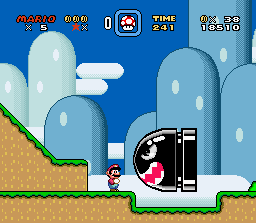 |
| "Oh Sh*t!" |

But considering we had one of the last release dates for this console, it wasn't too long a wait :)
It was at this point that I think me and my friends realised you could copy the game disks for your PC and subsequently rarely bought any new games for them. I know! I'm bad :(
With the exception of Shadow of The Beast.
Amazingly abstract Roger Dean artwork
I think it was the first time I felt 'immersed' during a game.
I had a real affinity for Psygnosis Games.
The Bitmap Brothers produced some great titles!
Due to Nintendo's reputation and conduct in the industry, SEGA made some catastrophic errors marketing their products.
They would develop new 'add-ons' for the Mega Drive to coincide with the advent of CD-ROM technology.
Gaining ground for brief periods of time, then conceding once again to Nintendo.
Their desperation to trounce their rivals was even more so exposed when they unveiled the 'SEGA 32X' at the 'Consumer Electronics Show' in 1994, after having previously announced the supposedly superior 'SEGA SATURN'.
 |
| It just looks odd! |
 |
| Ugly, ugly console :( |
 |
| SEGA Saturn 9.5 Million units sold worldwide |
The growing gap in the market made it possible for developers 'NEC' and 'Hudson Software' to introduce the 'Turbografx-16' or 'PC Engine' to Japan and North America.
This forced SEGA into third position in the 16-bit era.
Consumers had reservations about the upcoming '32-bit SEGA Saturn' due to the companies own undermining.
It still sold well in Japan but, once again due to their own actions, failed in the west.
SEGA, once again, were the first to release a new console but the haste and manner of it's release caused consumers to turn to the long anticipated "new kid on the block"
The 'SONY Playstation' - Fifth Generation 32-bit console -
With the added space that CD-ROM technology afforded, games shifted into full 3D realms and players were able to explore their environments instead of being "on rails" or "side-scrolling" adventures.
More emphasis was placed on graphics being 'realistic' and the content, itself, had become more dramatic and mature.
'Cut-scenes' were rendered in full 3D, rather than featuring dubious live action scenes.
The music accompanying the story was more expressive than ever before -
It is believed that the 'Playstations' success is due to the fact that it was marketed towards older gamers, who had grown up alongside video games, and was a good complement to your big TV and VCR.
December 1994, I remember queuing in a 'Beatties' store, with my mum, for my much anticipated Christmas present :)
Even though, in it's early days, there were hiccups. I still really got into this console.
Of the first few games I owned, only 'Wipeout' worked.
So, I got pretty good at that. And it was developed by 'Psygnosis'!
(I became very interested in 'The Designers Republic' afterwards - R.I.P. - DR)
We soon found out the first batch of 'Playstation's' shipped were all defective, so we had to take it back.
Luckily, to be replaced! "Phew!"
It's funny that we have Nintendo to thank for Sony's entrance into game consoles.
We could all have been playing with this -
The 'SONY Playstation' - Fifth Generation 32-bit console -
 |
| The first console to reach the 100 million units mark in sales. |
More emphasis was placed on graphics being 'realistic' and the content, itself, had become more dramatic and mature.
'Cut-scenes' were rendered in full 3D, rather than featuring dubious live action scenes.
The music accompanying the story was more expressive than ever before -
 |
| 'Metal Gear Solid by KONAMI' |
 |
| 'PsychoMantis from Metal Gear Solid' - "A real sicko!" |
December 1994, I remember queuing in a 'Beatties' store, with my mum, for my much anticipated Christmas present :)
Even though, in it's early days, there were hiccups. I still really got into this console.
Of the first few games I owned, only 'Wipeout' worked.
So, I got pretty good at that. And it was developed by 'Psygnosis'!
(I became very interested in 'The Designers Republic' afterwards - R.I.P. - DR)
We soon found out the first batch of 'Playstation's' shipped were all defective, so we had to take it back.
Luckily, to be replaced! "Phew!"
It's funny that we have Nintendo to thank for Sony's entrance into game consoles.
We could all have been playing with this -
 |
| The 'SONY SNES' - sounds like a blocked nose! |
Nintendo seemed to have reservations about CD-ROM technology and left dealings with SONY and later PHILIPS.
Even with the release of their 64-bit console the 'N64', Nintendo still opted for Cartridge-based games.
This prevented piracy but limited developers ambitions and revenue.
CD's were much cheaper to produce than Cartridges and held much more data.
Consequently many major developers turned their backs on Nintendo to begin producing titles for 'SONY Playstation'.
With the inception of the CD-ROM, marked a steady decline for Cartridge-based platforms.
(I have discovered a great retrospective, on this website, a visual history of Video Game Media.)
http://www.yostuffs.com/2010/05/evolution-of-video-game-media.html
I should note that I have never owned an N64, so I have a very limited scope of its overall performance and of the games featured on this platform.
I remember the controller being very confusing at the time :)
It had a trigger!
Which, as we know, became a standard feature on subsequent controllers.
The 90's ended with the 'SONY Playstation', a relative newcomer to the industry, becoming the dominant platform.
And, finally.........
- Welcome to my PERSONAL GAMING HISTORY -
Here is a list of my favourite 'Playstation' games:-
(Aside from WIPEOUT and TOMB RAIDER and the obvious FINAL FANTASY VII)
RESIDENT EVIL
TENCHU - Stealth Assassin
THE MISADVENTURES OF TRON BONNE
VAGRANT STORY
PARASITE EVE II
METAL GEAR SOLID
I think it was mainly the replay value of these titles that really stuck with me.
I must have milked them dry!
Although, at that period of time, I shared a room with my older brother (Aaran) who played a lot of these video games with me, which contributed to the overall enjoyment and experience.
We would challenge each other to best our recent achievements or beat a particularly difficult boss.
Sometimes this would result in either one of us (mainly Aaran) being generally pissed off at their success ;D
Continued in the 2000's.......
Even with the release of their 64-bit console the 'N64', Nintendo still opted for Cartridge-based games.
This prevented piracy but limited developers ambitions and revenue.
CD's were much cheaper to produce than Cartridges and held much more data.
Consequently many major developers turned their backs on Nintendo to begin producing titles for 'SONY Playstation'.
With the inception of the CD-ROM, marked a steady decline for Cartridge-based platforms.
(I have discovered a great retrospective, on this website, a visual history of Video Game Media.)
http://www.yostuffs.com/2010/05/evolution-of-video-game-media.html
I should note that I have never owned an N64, so I have a very limited scope of its overall performance and of the games featured on this platform.
I remember the controller being very confusing at the time :)
It had a trigger!
Which, as we know, became a standard feature on subsequent controllers.
The 90's ended with the 'SONY Playstation', a relative newcomer to the industry, becoming the dominant platform.
And, finally.........
- Welcome to my PERSONAL GAMING HISTORY -
Here is a list of my favourite 'Playstation' games:-
(Aside from WIPEOUT and TOMB RAIDER and the obvious FINAL FANTASY VII)
RESIDENT EVIL
TENCHU - Stealth Assassin
THE MISADVENTURES OF TRON BONNE
VAGRANT STORY
PARASITE EVE II
METAL GEAR SOLID
I think it was mainly the replay value of these titles that really stuck with me.
I must have milked them dry!
Although, at that period of time, I shared a room with my older brother (Aaran) who played a lot of these video games with me, which contributed to the overall enjoyment and experience.
We would challenge each other to best our recent achievements or beat a particularly difficult boss.
Sometimes this would result in either one of us (mainly Aaran) being generally pissed off at their success ;D
Continued in the 2000's.......


